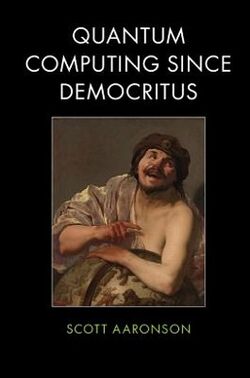Quantum Computing Since Democritus
 | |
| Author | Scott Aaronson |
|---|---|
| Publisher | Cambridge University Press |
Publication date | 2013 |
| Media type | |
| Pages | 398 |
| ISBN | ISBN:978-0521199568 |
Quantum Computing Since Democritus is a 2013 book on quantum information science written by Scott Aaronson.[1] It is loosely based on a course Aaronson taught at the University of Waterloo, Canada, the lecture notes for which are available online.[2]
Contents
Aaronson has stated that he intends the book to be at the same level as Leonard Susskind's The Theoretical Minimum or Roger Penrose's The Road to Reality;[3] Physics Today compared it to George Gamow's One Two Three... Infinity.[4] The book covers everything from computer science to mathematics to quantum mechanics and quantum computing, starting, as the title indicates, with Democritus.
Front Cover
The front cover image is an oil canvas painting of Democritus by Hendrik ter Brugghen dated 1628.[5] It depicts Democritus as a young, laughing hedonist who points in the distance, as to where the folly of mankind is found.
The image invokes Aaronson's discussions[6] on Democritus' concept of atoms and the void, which forms the foundational understanding of matter at the atomic level, is relevant to quantum computing, where manipulating and controlling individual quantum objects for calculations echoes the early atomic theory's significance.
Author
Scott Aaronson is a professor of theoretical computer science at the University of Texas at Austin. He was previously a member of faculty at MIT.[7]
Reception
Michael Nielsen called the book "a beautiful synthesis of what we know",[8] while Seth Lloyd praised it as "lucid", describing Aaronson as a "tornado of intellectual activity".[9]
In the Journal of the American Mathematical Society, Avi Wigderson considered it to have "much insight, wisdom, and fun", but conceded that it "is not for everyone'.[10]
References
- ↑ "Quantum computing democritus | Quantum physics, quantum information and quantum computation" (in en). http://www.cambridge.org/us/academic/subjects/physics/quantum-physics-quantum-information-and-quantum-computation/quantum-computing-democritus#KC913ZrlGKlyMFTd.97.
- ↑ "PHYS771 Quantum Computing Since Democritus". https://www.scottaaronson.com/democritus/.
- ↑ "Scott Aaronson: Quantum Computing since Democritus". https://motls.blogspot.com/2013/04/scott-aaronson-quantum-computing-since.html.
- ↑ Sullivan, Francis (2014-02-28). "Quantum Computing Since Democritus". Physics Today 67 (3): 54–56. doi:10.1063/PT.3.2315. ISSN 0031-9228. Bibcode: 2014PhT....67c..54S.
- ↑ "Democritus, Hendrick ter Brugghen, 1628" (in en). https://www.rijksmuseum.nl/en/collection/SK-A-2783.
- ↑ "PHYS771 Lecture 1: Atoms and the Void". https://www.scottaaronson.com/democritus/lec1.html.
- ↑ "NSF Honors Two Early Career Researchers With Alan T. Waterman Award | NSF - National Science Foundation" (in en). https://www.nsf.gov/news/news_summ.jsp?cntn_id=123406.
- ↑ "Comment by Michael Nielsen on Shtetl-Optimized Quantum Computing Since Democritus: The Buzz Intensifies" (in en-US). 22 March 2013. https://www.scottaaronson.com/blog/?p=1277#comment-66937.
- ↑ "Quantum Computing since Democritus - Cambridge University Press" (in en). http://www.cambridge.org/catalogue/catalogue.asp?isbn=9781107302105.
- ↑ Wigderson, Avi (2014). "Quantum Computing Since Democritus Book Review". Journal of the American Mathematical Society 61 (10): 1218–1220. doi:10.1090/noti1176. https://www.ams.org/notices/201410/rnoti-p1218.pdf.
 |
